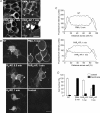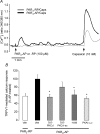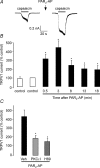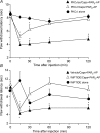Protease-activated receptor 2 sensitizes TRPV1 by protein kinase Cepsilon- and A-dependent mechanisms in rats and mice
- PMID: 16793902
- PMCID: PMC1819458
- DOI: 10.1113/jphysiol.2006.111534
Protease-activated receptor 2 sensitizes TRPV1 by protein kinase Cepsilon- and A-dependent mechanisms in rats and mice
Abstract
Proteases that are released during inflammation and injury cleave protease-activated receptor 2 (PAR2) on primary afferent neurons to cause neurogenic inflammation and hyperalgesia. PAR2-induced thermal hyperalgesia depends on sensitization of transient receptor potential vanilloid receptor 1 (TRPV1), which is gated by capsaicin, protons and noxious heat. However, the signalling mechanisms by which PAR2 sensitizes TRPV1 are not fully characterized. Using immunofluorescence and confocal microscopy, we observed that PAR2 was colocalized with protein kinase (PK) Cepsilon and PKA in a subset of dorsal root ganglia neurons in rats, and that PAR2 agonists promoted translocation of PKCepsilon and PKA catalytic subunits from the cytosol to the plasma membrane of cultured neurons and HEK 293 cells. Subcellular fractionation and Western blotting confirmed this redistribution of kinases, which is indicative of activation. Although PAR2 couples to phospholipase Cbeta, leading to stimulation of PKC, we also observed that PAR2 agonists increased cAMP generation in neurons and HEK 293 cells, which would activate PKA. PAR2 agonists enhanced capsaicin-stimulated increases in [Ca2+]i and whole-cell currents in HEK 293 cells, indicating TRPV1 sensitization. The combined intraplantar injection of non-algesic doses of PAR2 agonist and capsaicin decreased the latency of paw withdrawal to radiant heat in mice, indicative of thermal hyperalgesia. Antagonists of PKCepsilon and PKA prevented sensitization of TRPV1 Ca2+ signals and currents in HEK 293 cells, and suppressed thermal hyperalgesia in mice. Thus, PAR2 activates PKCepsilon and PKA in sensory neurons, and thereby sensitizes TRPV1 to cause thermal hyperalgesia. These mechanisms may underlie inflammatory pain, where multiple proteases are generated and released.
Figures








Comment in
-
Pain TRP-ed up by PARs.J Physiol. 2007 Feb 1;578(Pt 3):631. doi: 10.1113/jphysiol.2006.126425. Epub 2006 Dec 21. J Physiol. 2007. PMID: 17185331 Free PMC article. No abstract available.
Similar articles
-
Protease-activated receptor 2 sensitizes the capsaicin receptor transient receptor potential vanilloid receptor 1 to induce hyperalgesia.J Neurosci. 2004 May 5;24(18):4300-12. doi: 10.1523/JNEUROSCI.5679-03.2004. J Neurosci. 2004. PMID: 15128844 Free PMC article.
-
Protease-activated receptor 2 sensitizes the transient receptor potential vanilloid 4 ion channel to cause mechanical hyperalgesia in mice.J Physiol. 2007 Feb 1;578(Pt 3):715-33. doi: 10.1113/jphysiol.2006.121111. Epub 2006 Nov 23. J Physiol. 2007. PMID: 17124270 Free PMC article.
-
Neurokinin-1 receptor enhances TRPV1 activity in primary sensory neurons via PKCepsilon: a novel pathway for heat hyperalgesia.J Neurosci. 2007 Oct 31;27(44):12067-77. doi: 10.1523/JNEUROSCI.0496-07.2007. J Neurosci. 2007. PMID: 17978048 Free PMC article.
-
Neurotrophic Factors and Nociceptor Sensitization.In: Kruger L, Light AR, editors. Translational Pain Research: From Mouse to Man. Boca Raton (FL): CRC Press/Taylor & Francis; 2010. Chapter 2. In: Kruger L, Light AR, editors. Translational Pain Research: From Mouse to Man. Boca Raton (FL): CRC Press/Taylor & Francis; 2010. Chapter 2. PMID: 21882462 Free Books & Documents. Review.
-
The pharmacological challenge to tame the transient receptor potential vanilloid-1 (TRPV1) nocisensor.Br J Pharmacol. 2008 Dec;155(8):1145-62. doi: 10.1038/bjp.2008.351. Epub 2008 Sep 22. Br J Pharmacol. 2008. PMID: 18806809 Free PMC article. Review.
Cited by
-
Update on protease-activated receptor 2 in inflammatory and autoimmune dermatological diseases.Front Immunol. 2024 Sep 19;15:1449126. doi: 10.3389/fimmu.2024.1449126. eCollection 2024. Front Immunol. 2024. PMID: 39364397 Free PMC article. Review.
-
Hypersensitivity Induced by Activation of Spinal Cord PAR2 Receptors Is Partially Mediated by TRPV1 Receptors.PLoS One. 2016 Oct 18;11(10):e0163991. doi: 10.1371/journal.pone.0163991. eCollection 2016. PLoS One. 2016. PMID: 27755539 Free PMC article.
-
Thrombin and trypsin directly activate vagal C-fibres in mouse lung via protease-activated receptor-1.J Physiol. 2010 Apr 1;588(Pt 7):1171-7. doi: 10.1113/jphysiol.2009.181669. Epub 2010 Feb 8. J Physiol. 2010. PMID: 20142268 Free PMC article.
-
Contribution of TRPC3 to store-operated calcium entry and inflammatory transductions in primary nociceptors.Mol Pain. 2014 Jun 26;10:43. doi: 10.1186/1744-8069-10-43. Mol Pain. 2014. PMID: 24965271 Free PMC article.
-
Sensitization of ASIC3 by proteinase-activated receptor 2 signaling contributes to acidosis-induced nociception.J Neuroinflammation. 2017 Jul 28;14(1):150. doi: 10.1186/s12974-017-0916-4. J Neuroinflammation. 2017. PMID: 28754162 Free PMC article.
References
-
- Amadesi S, Nie J, Vergnolle N, Cottrell GS, Grady EF, Trevisani M, Manni C, Geppetti P, McRoberts JA, Ennes H, Davis JB, Mayer EA, Bunnett NW. Protease-activated receptor 2 sensitizes the capsaicin receptor transient receptor potential vanilloid receptor 1 to induce hyperalgesia. J Neurosci. 2004;24:4300–4312. - PMC - PubMed
-
- Barajas-Lopez C, Espinosa-Luna R, Gerzanich V. ATP closes a potassium and opens a cationic conductance through different receptors in neurons of guinea pig submucous plexus. J Pharmacol Exp Ther. 1994;268:1397–1402. - PubMed
-
- Bhave G, Zhu W, Wang H, Brasier DJ, Oxford GS, Gereau RW., 4th cAMP-dependent protein kinase regulates desensitization of the capsaicin receptor (VR1) by direct phosphorylation. Neuron. 2002;35:721–731. - PubMed
Publication types
MeSH terms
Substances
Grants and funding
LinkOut - more resources
Full Text Sources
Other Literature Sources
Miscellaneous

